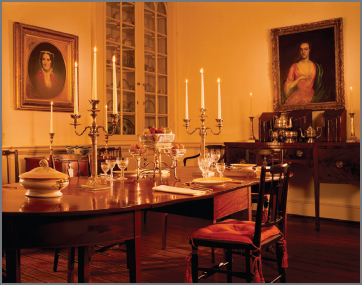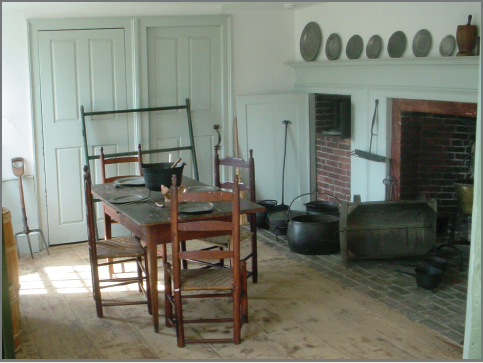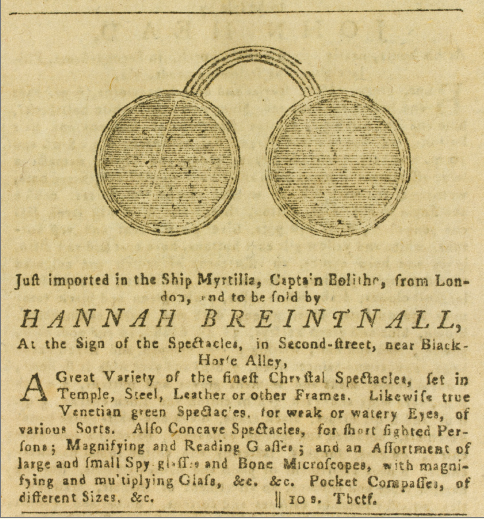America’s History: Printed Page 118
THINKING LIKE A HISTORIAN |  |
Women’s Labor
As these documents show, women bore the responsibility for a wide variety of work, from keeping up households to supporting themselves independently.
ThomasTusser, Five Hundred Pointes of Good Husbandrie, 1557. Advice manuals like Tusser’s circulated for generations and offered guidance on household management. In this couplet, Tusser stresses the virtues of a wife’s economy and hard work.
Wife, make thine own candle,
Spare penny to handle.
Provide for thy tallow ere frost cometh in,
And make thine own candle ere winter begin.
Eliza Lucas, letters, 1740–1742. George Lucas owned three South Carolina plantations, but, as lieutenant governor of Antigua, he was frequently absent. When his daughter was sixteen, he gave her responsibility for managing them. She introduced indigo cultivation in South Carolina, and it soon became the colony’s second-leading cash crop. These letters were written when she was between the ages of eighteen and twenty.
May 2, 1740
“I have the business of 3 plantations to transact, which requires much writing and more business and fatigue of other sorts than you can imagine. But least you should imagine it too burthensom to a girl at my early time of life, give me leave to answer you: I assure you I think myself happy that I can be useful to so good a father, and by rising very early I find I can go through much business.”
July 1740
“Wrote my Father a very long letter on his plantation affairs and on … the pains I had taken to bring the Indigo, Ginger, Cotton and Lucerne and Casada to perfection, and had greater hopes from the Indigo … than any of the rest of the things I tried.”
February 6, 1741
“… I have a Sister to instruct and a parcel of little Negroes whom I have undertaken to teach to read.”
April 23, 1741
“Wrote to my Father informing him of the loss of a Negro man — also the boat being overset in Santilina [Saint Helena] Sound and 20 barrels of Rice lost.”
[1742]
“Wont you laugh at me if I tell you I am so busey in providing for Posterity I hardly allow my self time to Eat or sleep. … I am making a large plantation of Oaks which I look upon as my own property, whether my father gives me the land or not; and therefore I design many years hence when oaks are more valueable than they are now — which you know they will be when we come to build fleets.”
[c. June 1742]
“I am engaged with the rudiments of the law to which I am yet but a stranger. … If You will not laugh too immoderately at me I’ll Trust you with a secrett. I have made two wills already.”
Mary Vial Holyoke, diary excerpts, 1761. Mary Vial Holyoke, wife of a prominent physician in Salem, Massachusetts, kept a diary that offers a glimpse of the range of household tasks women faced.
[1761]
Jan. 16: Began upon the firkin of butter of 40 lb. …
22: Bo’t hog, weighed 182 pounds, at 2/5. Salted hog with half Lisbon & half saltertudas [Tortugas] salt. …
Mar. 4: Ironing. …
7: Scower’d pewter. …
17: Made the Dr. six Cravats marked H. …
Apr. 17: Made soap. …
23: Dressed a Calves Head turtle fashion. …
May 20: Began to whitewash. …
28: Ironed. …
30: Scower’d pewter. …
July 7: Scowered rooms. …
Colonial house interiors in Germantown, Pennsylvania, and Augusta, Maine. These images show the dining room of Benjamin Chew, a wealthy Philadelphia lawyer (below), and the kitchen of the Howards, an extended family of soldiers and merchants on the Maine frontier (bottom).
 Source: Photo by Ron Blunt, Courtesy of Cliveden, a National Trust Historic Site, Philadelphia, PA.
Source: Photo by Ron Blunt, Courtesy of Cliveden, a National Trust Historic Site, Philadelphia, PA. Source: Old Fort Western, Augusta, Maine.
Source: Old Fort Western, Augusta, Maine.Business advertisement in the Pennsylvania Gazette, 1758. Not all women’s work was done in the home. Hannah Breintnall, a Philadelphia widow, ran a tavern before opening a shop specializing in eyeglasses.
 Source: Library Company of Philadelphia.
Source: Library Company of Philadelphia.Hilliad Magna: Being the Life and Adventures of Moll Placket-Hole, 1765. Moll Placket-Hole was a satirical, seven-page pamphlet that purported to describe the life of a Philadelphia prostitute. Moll was an eighteenth-century term for a loose woman or prostitute, while placket-hole referred to a slit that might be found in a woman’s skirt.
MOLL PLACKET-HOLE was born in a Bawdy House in a Lane in the City of Brotherly Love. … [A]t the Age of twelve (Shocking to consider!) … [her] Mother sold her Virginity — sold it for the Trifling Consideration of Ten Pounds. Her Purchaser was soon cloyed and abandoned her. Virtue lost and good Reputation (if ever she had it) gone, she commenced open Prostitute and dealt out her Favours to the highest Bidder. … [S]he understood the Trade and set up a Bawdy-House. … It was necessary, however, that a Man should live with her, that they might appear to the Publick, as honest Housekeepers. … The Trade became at last so publick, that it gave Offence to her sober Neighbours. … [T]he Town tired out with her Insolence, and her Escape from Justice in a regular Manner, set a Mob (many of whom had been her Beneficiaries) upon her. They pulled down her House, and destroyed her Furniture &c. She stormed and raged and swore if her Customers would not build her a better House, she would expose them. … They opened a Subscription, and a hundred Pounds were subscribed in one Day.
Sources: (1) Alice Morse Earle, Home Life in the Colonial Days (New York: The Macmillan Company, 1898), 35; (2) From The Letterbook of Eliza Lucas Pinckney, 1739–1762, edited by Elise Pinckney, University of North Carolina Press, 1972. Based on original documents from the South Carolina Historical Society. Courtesy of the South Carolina Historical Society; (3) George Francis Dow, ed., The Holyoke Diaries, 1709–1856 (Salem, MA: The Essex Institute, 1911), 49–51; (6) Hilliad Magna: Being the Life and Adventures of Moll Placket-Hole ([Philadelphia]: Printed [by Anthony Armbruster], 1765).
ANALYZING THE EVIDENCE
Question
Compare the advice manual (source 1) with Eliza Lucas’s letters and Mary Vial Holyoke’s diary. What themes do they share in common, and how do these women’s experiences deviate from the expectations of the advice book authors?
Question
Eliza Lucas supervised slave labor, and Mary Vial Holyoke very likely employed servants. How do these facts affect the way you interpret sources 2 and 3?
Question
Compare the two house interiors (source 4). What work would women have done in these spaces? The Chews were a slaveholding family, and the Howards probably employed servants. With that in mind, consider the relationship between supervisory and manual labor.
Question
Hannah Breintnall was a well-to-do widow, while Moll Placket-Hole was a fictional stereotype. What does Breintnall’s experience tell us about the prospects of a woman living without a male protector? How does Moll Placket-Hole shed light on popular attitudes toward such women?
PUTTING IT ALL TOGETHER
Question
With all these sources in mind, write a short essay that considers the role of hierarchy and social power in women’s work. How did economic and social status affect the work that was expected of women? How did the women whose lives are documented here navigate the challenges and opportunities they faced? And how does the satire of Moll Placket-Hole illuminate popular attitudes toward women’s work and its place in colonial society?